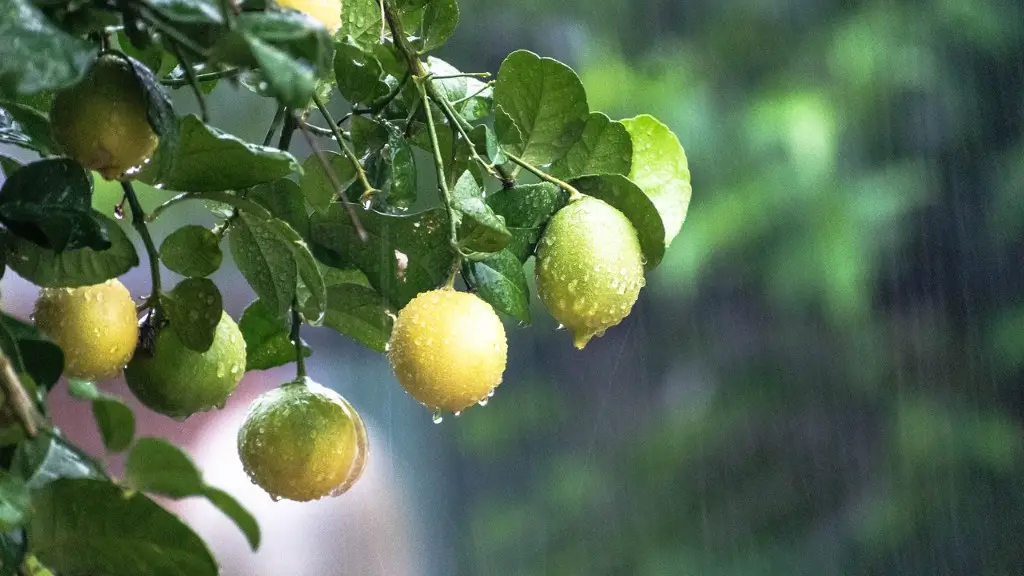Meyer lemon trees are a hybrid of traditional lemon trees, producing sweet yet tart lemons that are a fantastic addition to many dishes and drinks. A fully grown tree can reach up to fifteen feet in height, with nine feet width and even more if properly pruned and cared for. When grown in an outdoor location, an improved Meyer lemon tree can grow as tall as twenty feet. The improved Meyer lemon tree is especially notable for its large, round fruits that can easily reach four to six inches in diameter, making them larger than traditional lemons.
Leaves of an improved Meyer lemon tree tend to be darker than a traditional tree, typically bearing a glossy green that’s pleasing to the eye. The branches of the improved Meyer lemon tree will also form more spread-out, arching branches than other citrus trees. They can quickly add to the beauty of any yard, balcony or garden.
For indoor growing, the improved Meyer lemon tree can shrink in size and reach a maximum of seven feet in height with proper pruning and maintenance. They also require much less water than a typical lemon tree, making them an ideal option if you have minimal space. It is, however, important to pay attention to the amount of water and sunlight that your improved Meyer lemon tree receives. Too little water, and the leaves start to yellow and shrivel, too much and your improved Meyer lemon tree will start to grow too quickly.
If you’re looking for a lemon tree that provides large lemons but isn’t too big, the improved Meyer lemon tree is the perfect choice. Pruned and handled properly, you can easily get a perfect balance between tree size and plenty of tasty lemons. Surprisingly hardy, Meyer lemon trees can also be grown comfortably in a range of climates, from mild continental up through subtropical. Because of its compact size, an improved Meyer lemon tree can also serve as a great and useful container-grown tree.
At the end of each year, the improved Meyer lemon tree will produce an abundance of sweetly scented blossoms in shades of yellow, white, and pink. As the warm temperatures begin, the flowers will begin to open giving way to the lemons. When properly cared for, an improved Meyer lemon tree can effortlessly produce more than three hundred fruits in a season, making it ideal for creating sweet foods, drinks, and more.
How to Care for an Improved Meyer Lemon Tree
When caring for an improved Meyer lemon tree, the most important factor is to ensure that optimal growing conditions are met. It is essential for the tree to receive enough direct sunlight for at least five hours each day and it is vital to provide the tree with enough water. It is recommended that the tree is watered when the top two inches of the soil dry out. Additionally, proper pruning is necessary for the tree to maintain an optimum size.
Troubleshooting and Common Problems
Improper conditions can lead to several common problems among the improved Meyer lemon tree. One of the most common issues is dieback, which is caused by inadequate sunlight and limited water access. If the tree experiences yellowing of the leaves, this can be caused by the soil being too soggy. To avoid this, it is necessary to check the water level regularly.
If insects or pests begin to appear, it is important to use a pesticide to avoid the tree becoming infested. Additionally, the leaves can become affected by greening, which occurs when there is a deficiency in nutrients such as nitrogen.
Fruits and Harvesting
For harvesting improved Meyer lemon trees, it is important to wait until the lemons have ripened. An easy way to check for ripeness is to taste one and assess its sweetness – lightly ripened lemons will feel firmer and contain a tart flavor. If you choose to wait until the lemons are fully ripe, you will be able to enjoy a sweeter/bitter taste.
Leaving the lemons on the tree for too long will reduce the flavor, so it is essential to harvest the fruit the moment it has reached the desired sweetness. Overall, it is recommended to check the tree regularly for fruits that are ready to be harvested, as this will ensure an optimal yield.
Pruning and Maintenance
To maintain a healthy and productive improved Meyer lemon tree, regular pruning is essential. This should be done at least two times per season to make sure that the tree stays in shape and results in a bountiful harvest. Pruning involves the removal of deadwood, in addition to any branches or flowers that must be removed for better shape and light conditions.
To achieve optimal health, it’s recommended that you fertilize the tree with an appropriate citrus fertilizer each month. This will provide the tree with the essential nutrients that it needs to remain healthy and active. Additionally, any dying limbs should be easily removed to avoid overpruning.
Disease Prevention
There are several diseases that can lead to damage in the improved Meyer lemon tree, such as citrus greening, canker, and foot rot. Citrus greening is caused by an insect and leads to yellowing of leaves as well as underdeveloped fruits. Canker can cause dark spots on the leaves, whereas foot rot is caused by too much moisture. To avoid these, it is important to monitor the tree for symptoms and address them quickly.
To prevent further damage, it is important to take the necessary steps for pest management and maintain a clean environment around the tree. Additionally, you should consult anexpert for advice and treatment options if an issue isdetected early.

